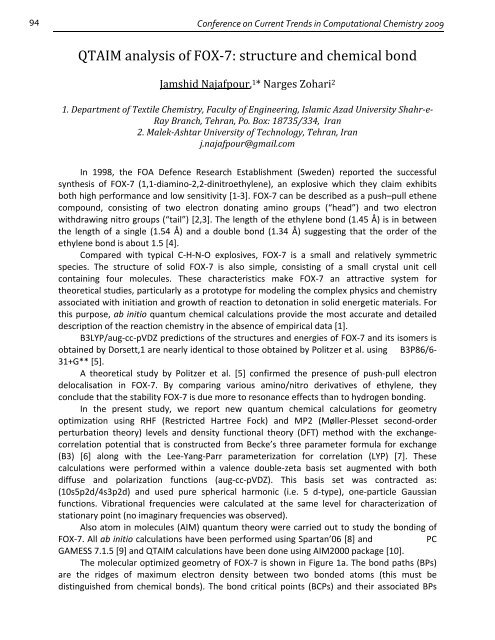Proceedings - Interdisciplinary Center for Nanotoxicity
Proceedings - Interdisciplinary Center for Nanotoxicity
Proceedings - Interdisciplinary Center for Nanotoxicity
Create successful ePaper yourself
Turn your PDF publications into a flip-book with our unique Google optimized e-Paper software.
94<br />
Conference on Current Trends in Computational Chemistry 2009<br />
QTAIM analysis of FOX‐7: structure and chemical bond<br />
Jamshid Najafpour, 1* Narges Zohari 2<br />
1. Department of Textile Chemistry, Faculty of Engineering, Islamic Azad University Shahre<br />
Ray Branch, Tehran, Po. Box: 18735/334, Iran<br />
2. MalekAshtar University of Technology, Tehran, Iran<br />
j.najafpour@gmail.com<br />
In 1998, the FOA Defence Research Establishment (Sweden) reported the successful<br />
synthesis of FOX‐7 (1,1‐diamino‐2,2‐dinitroethylene), an explosive which they claim exhibits<br />
both high per<strong>for</strong>mance and low sensitivity [1‐3]. FOX‐7 can be described as a push–pull ethene<br />
compound, consisting of two electron donating amino groups (“head”) and two electron<br />
withdrawing nitro groups (“tail”) [2,3]. The length of the ethylene bond (1.45 Å) is in between<br />
the length of a single (1.54 Å) and a double bond (1.34 Å) suggesting that the order of the<br />
ethylene bond is about 1.5 [4].<br />
Compared with typical C‐H‐N‐O explosives, FOX‐7 is a small and relatively symmetric<br />
species. The structure of solid FOX‐7 is also simple, consisting of a small crystal unit cell<br />
containing four molecules. These characteristics make FOX‐7 an attractive system <strong>for</strong><br />
theoretical studies, particularly as a prototype <strong>for</strong> modeling the complex physics and chemistry<br />
associated with initiation and growth of reaction to detonation in solid energetic materials. For<br />
this purpose, ab initio quantum chemical calculations provide the most accurate and detailed<br />
description of the reaction chemistry in the absence of empirical data [1].<br />
B3LYP/aug‐cc‐pVDZ predictions of the structures and energies of FOX‐7 and its isomers is<br />
obtained by Dorsett,1 are nearly identical to those obtained by Politzer et al. using B3P86/6‐<br />
31+G** [5].<br />
A theoretical study by Politzer et al. [5] confirmed the presence of push‐pull electron<br />
delocalisation in FOX‐7. By comparing various amino/nitro derivatives of ethylene, they<br />
conclude that the stability FOX‐7 is due more to resonance effects than to hydrogen bonding.<br />
In the present study, we report new quantum chemical calculations <strong>for</strong> geometry<br />
optimization using RHF (Restricted Hartree Fock) and MP2 (Møller‐Plesset second‐order<br />
perturbation theory) levels and density functional theory (DFT) method with the exchange‐<br />
correlation potential that is constructed from Becke’s three parameter <strong>for</strong>mula <strong>for</strong> exchange<br />
(B3) [6] along with the Lee‐Yang‐Parr parameterization <strong>for</strong> correlation (LYP) [7]. These<br />
calculations were per<strong>for</strong>med within a valence double‐zeta basis set augmented with both<br />
diffuse and polarization functions (aug‐cc‐pVDZ). This basis set was contracted as:<br />
(10s5p2d/4s3p2d) and used pure spherical harmonic (i.e. 5 d‐type), one‐particle Gaussian<br />
functions. Vibrational frequencies were calculated at the same level <strong>for</strong> characterization of<br />
stationary point (no imaginary frequencies was observed).<br />
Also atom in molecules (AIM) quantum theory were carried out to study the bonding of<br />
FOX‐7. All ab initio calculations have been per<strong>for</strong>med using Spartan’06 [8] and PC<br />
GAMESS 7.1.5 [9] and QTAIM calculations have been done using AIM2000 package [10].<br />
The molecular optimized geometry of FOX‐7 is shown in Figure 1a. The bond paths (BPs)<br />
are the ridges of maximum electron density between two bonded atoms (this must be<br />
distinguished from chemical bonds). The bond critical points (BCPs) and their associated BPs



